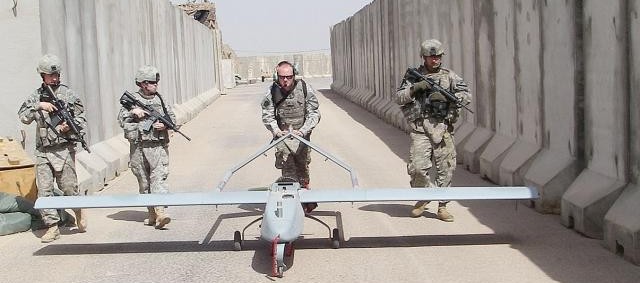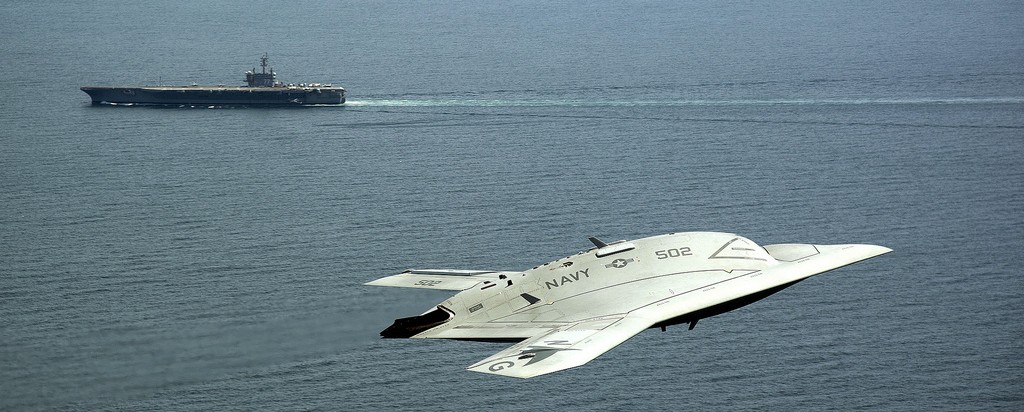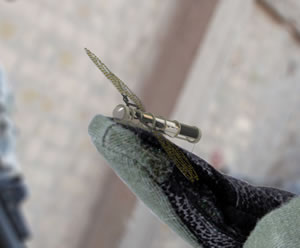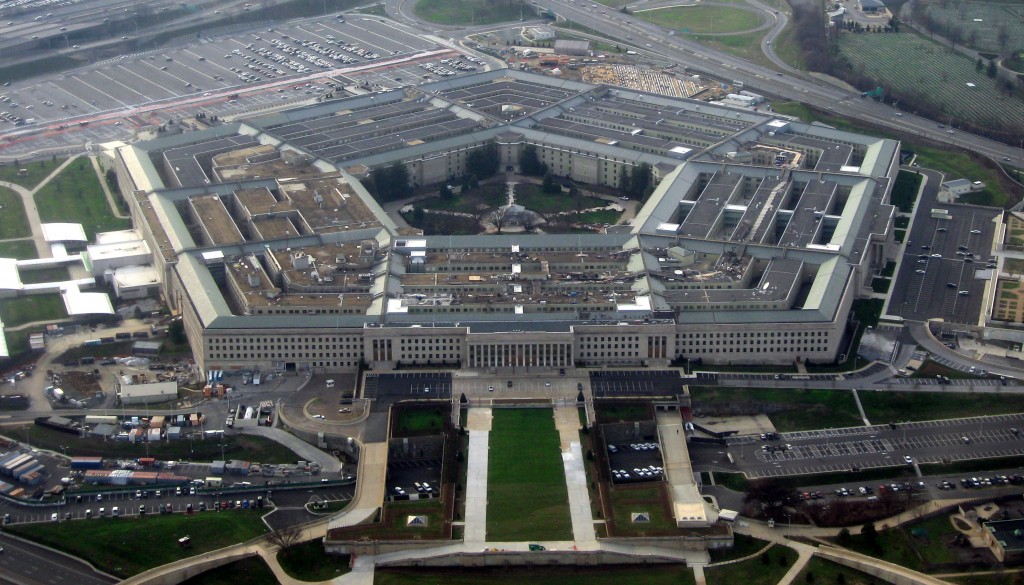For an examination of how drones factor into the House and Senate defense spending bills for FY16, go here. For a breakdown of spending on the MQ-9 Reaper, click here.
This guide is out of date. For drones in the Fiscal Year 2017 budget proposal, click here.
By Dan Gettinger
Drones are on the wish lists of the Army, the Navy and Marines, and the Air Force. In a short speech at the Department of Homeland Security on February 2, President Obama unveiled his nearly $4 trillion budget proposal for Fiscal Year 2016. It contains $536 billion in baseline spending and $51 billion in Overseas Contingency Operations* for the Department of Defense, exceeding the budget caps known as “sequestration” by $36 billion. In several hours of briefings, officials from each service outlined their portions of the budget and defended the rise in spending past the caps set by Congress. This is not the final budget. Lawmakers are likely to change it significantly, axing many of Obama’s proposals. These documents, and not the final product, are representative of the Pentagon’s drone plans.
The Pentagon plans on spending $2.9 billion on acquiring a variety of unmanned systems. This is out of a total allocation of $48.8 billion on aircraft and related systems across the services, the largest procurement allocation in the Pentagon’s proposed budget and almost double the $25.6 billion intended for shipbuilding and maritime systems. Here’s what you need to know about the Department of Defense’s drone spending plans for FY 2016:
DoD Source Materials
- DoD Budget Request Materials Website
- Overview of Defense FY 2016 Budget Request Powerpoint
- All DoD Procurement Programs
- Major Weapons Systems Procurement
- Air Force Budget Materials – Aircraft Procurement
- Navy and Marine Corps Budget Materials – Aircraft Procurement
- Army Budget Materials – Aircraft Procurement
Procurement
Air Force
- The big-ticket item in the UAV budget is for the planned procurement of 29 new MQ-9 Reaper drones for a total of $821 million. An additional $82.5 million will be drawn from the Overseas Contingency Operations budget for modifications to the aircraft, specifically $69 million for extending the range. The planned order is up from 20 in FY 2014 and 24 in FY 2015. The Reapers are intended to eventually replace the 5 remaining MQ-1 Predator Combat Air Patrols. Read On: “White House Wants More Reaper Drones to Fight ISIS” – Patrick Tucker // Defense One. And On: “Drone Spending: MQ-9 Reaper” – Dan Gettinger // CSD
- The Air Force intends to spend $769.1 million on 5,950 Hellfire AGM-114R missiles, an air-to-ground munition that is carried by the Predator and Reaper drones as well as several other manned aerial platforms.
- In the Air Force budget briefing on Monday, Deputy Assistant Secretary for Budget James Martin said that the Air Force has included funding for higher incentive pay for drone pilots. Read On: “Air Force raises monthly incentive pay for drone pilots” – Jeff Schogol // Air Force Times
- The Air Force will extend the life of the high-altitude manned U-2 spy plane from 2016 until 2019 due to the continuing high demand for aerial intelligence. The U-2 is eventually supposed to be replaced by the RQ-4 Global Hawk, an unmanned high-altitude, long-endurance surveillance aircraft. Read On: USAF Budget Funds Munitions, Keeps U-2” – Aaron Mehta // Defense News
Navy and Marines
- The Navy will acquire three Northrop Grumman MQ-4C Tritons, another big ticket item. The Triton—the maritime variant of the Air Force’s RQ-4 Global Hawk—is a high-altitude, long-endurance surveillance and reconnaissance aircraft with a range of 2,000 miles. The three drones will set the Navy back $548.8 million. The service had initially intended to buy four Tritons. Read On: “US Navy Budget Request Funds Carrier GW” – Christopher P. Cavas // Defense News
- The Navy and the Marines plan on purchasing seven Boeing Insitu RQ-21A Blackjack drones, a small tactical drone built specifically for the Navy. Three are for the Naval Special Warfare Command at $55 million (paid for under Overseas Contingency Operations fund). And four for the Marines at $84.9 million. The Marines will also spend $3.8 million on upgrades to the RQ-7 Shadow and $3.4 million on support and training for the RQ-11 Raven, two other small fixed-wing tactical drones.
- The Navy also intend to purchase two Northrop Grumman MQ-8 Fire Scouts, an unmanned helicopter, for a total of $120 million. The Navy had previously intended to stop spending money on due to cost overruns. Read On: “Unit Costs Surge for MQ-8 Fire Scout Drone” – Brendan McGarry // DOD Buzz

Army
- The Army wants to buy 17 General Atomics MQ-1C Gray Eagle drones, a derivative of the Air Force’s MQ-1 Predator, for a total of $383 million: $276.9 million for the aircraft and $106.2 million for the payloads (sensors and intelligence equipment). This number is down from previous years; in FY 2014 the Army went for 23 Gray Eagles. Two of the 17 Gray Eagles will be purchased with OCO funds.
- The Army plans to invest $89.7 million in upgrades to its fleet of RQ-7 Shadow UAVs.
- The Army plans to purchase 64 AH-64E Apache manned attack helicopters for a total of $1.325 billion. In their defense of the intended purchases at a briefing, Army Budget Director Thomas Horlander and Army Budget Deputy Director Davis Welch argued that this advanced version of the Apache adds a number of technological improvements, including an upgrade that would allow for pairing of manned and unmanned aircraft. Read On: “MUM-T Is The Word For AH-64E: Helos Fly, Use Drones.” – Richard Whittle // Breaking Defense.
Research, Development, Test & Evaluation (RDT&E)
In the proposed defense spending budget, each service of the military included funding requests for dozens of research and development programs relating to unmanned systems and robotics. The largest portion of these are requests for funding for ongoing research of autonomous systems and control mechanisms for multiple unmanned systems. Below is a selection of the projects picked from the budget proposals of each service. Included in each item listing is a reference number and link. Reference: [Project ID / Name] + [Budget Document Link]
Air Force
- Of the $821 million going to purchase the MQ-9 Reapers, the Air Force wants to spend $123.4 million on research and development. $51.3 million will go to improving the Ground Control Stations from which pilots operate the drones by adding “new LINUX processors, high definition monitors, ergonomic improvements, improved human-machine interfaces, open systems architecture, and improved crew habitability.” In other words, the service is hoping to figure out how to make these stations more comfortable. Another $47 million will go to general upgrades and testing, and the remaining on various sensor and radar packages. Reference: PE 0205219F / MQ-9 UAV “Research, Development, Test & Evaluation, Air Force, Vol. 3 Pt. 1”
- While the Air Force won’t be purchasing any new RQ-4 Global Hawks, it will spend $208.1 million on RDT&E for the high-altitude, long endurance unmanned spy plane. Reference: PE 0305220F / RQ-4 UAV “Research, Development, Test & Evaluation, Air Force, Vol.3 Pt.2”
- The Air Force wants to spend $27.578 million on three research programs involving the control interface for unmanned aircraft. The Air Force plans on continuing development of “advanced control automation techniques” and teaming manned/unmanned aircraft in contest/dynamic environments. Reference: 622403 / Flight Controls and Pilot-Vehicle Interface “Research, Development, Test & Evaluation, Air Force, Vol. 1”
- In FY 2016, the Air Force wants to continue testing ways to enhance the ability of airmen to operate multiple unmanned vehicles at once. One project, costing $6.602 million, will investigate the “human role in semiautonomous systems” and “explore airman-autonomy teaming methods.” Reference: No. 625329 / Sensory Evaluation and Decision Science “Research, Development, Test & Evaluation, Air Force, Vol. 1”
- For the Autonomous Systems Control research project, the Air Force wants $24.245 million. Specifically, this project addresses the continued development “of airborne control of teams of unmanned aircraft.” Reference: 634927 / Flight Systems Control “Research, Development, Test & Evaluation, Air Force, Vol. 1”

Navy and Marines
- The Navy pared funding for the controversial Unmanned Carrier-Launched Airborne Surveillance and Strike (UCLASS) development program from over $400 million to $134.7 million. The Navy will initiate a review of the program and push back its due date to 2023. Reference: PE 0604404N / (U)Unman Carrier Launch A/B Surv & Strk(UCLASS)Sys “Research, Development, Test & Evaluation, Navy – Book 3.” Read On: “Navy Pushes UCLASS Fielding Date, Air Segment Request for Proposal” – Sam LaGrone // USNI News
- $26.885 million for researching Directed Energy technology (lasers). The ship-based lasers are intended to “defeat small boat swarms, UAV [Unmanned Aerial Vehicle] swarms…” Reference: “Research, Development, Test & Evaluation, Navy – Book 1” Read On: “What You Need to Know About Lasers” – Dan Gettinger // CSD
- $34 million towards researching an Unmanned Surface Vehicle. This USV is intended to be used to counter mines and could be launched from a Littoral Combat Ship. Reference: 1234 / Unmanned Surface Vehicle (USV) “Research, Development, Test & Evaluation, Navy – Book 2”
- $25 million towards an large displacement Unmanned Undersea Vehicle UUV. This research is aimed at introducing a line of autonomous large displacement UUVs that can operate for extended periods of time. Reference: 2094 / Unmanned Underwater Vehicle “Research, Development, Test & Evaluation, Navy – Book 2”
- $17.392 million towards the Knifefish Surface Mine Countermeasure Unmanned Undersea Vehicle (SMCM UUV) program that will “support clandestine mine detection capability against volume and bottom mines.” Reference: 3123 / SMCM UUV “Research, Development, Test & Evaluation, Navy – Book 2”

Army
- $40.374 million on developing a Tactical Unmanned Ground Vehicle, the Common Robotic System (CRS-(I)). The CRS-(1) is a “man-packable, miniature (<25lbs), highly mobile, unmanned robotic system with advanced sensors/mission modules for dismounted soldiers.” This project is slotted to receive a massive increase investment over FY 2015 when it received $2.8 million. Reference: Project Element 0604641A / TACTICAL UNMANNED GROUND VEHICLE. Research, Development, Test & Evaluation, Army, Vol. 5A
- $8.426 million on Robotics Technology research. This project funds the Army’s participation in the Robotics Collaborative Technology Alliance (CTA), a group of companies and universities that work with the Army Research Laboratory in Adelphi, Maryland. Reference: TS2 / Robotics Technology “Research, Development, Test & Evaluation, Army, Vol.2”
- $7.592 million for Intelligent Systems Technology Research that will investigate “sensing and autonomy technologies developed for unmanned systems such as maneuver and tactical behavior algorithms…” Reference: H91 / Ground Vehicle Technology “Research, Development, Test & Evaluation, Army, Vol.2”
- $4.242 million for researching Human-Robot Interaction (HRI) in order to enable the “interaction with multiple semi-autonomous unmanned vehicles.” Reference: H70 / Human Fact Eng Sys Dev “Research, Development, Test & Evaluation, Army, Vol.2”
- $6.489 million for Unmanned and Optionally Manned Technologies that will “ Design and develop collaboration and cooperation algorithms to support goal of intelligent teaming for manned unmanned operations.” Reference: 47A / AERON & ACFT Wpns Tech “Research, Development, Test & Evaluation, Army, Vol.2”
- $7.233 million for researching robotics autonomy, manipulation, and portability. This fund supports two projects that investigate human-robot interfaces and intelligence systems. Reference: T63 / Robotics Autonomy, Manipulation, & Portability Rsh “Research, Development, Test & Evaluation, Army, Vol.1”
- $2.029 million on researching algorithms that can help the soldier “predict, explain, and characterize target and background signature content.” Reference: 305 / ATR Research “Research, Development, Test & Evaluation, Army, Vol.1”
- $5.841 million to the Army Research Laboratory in Maryland for researching autonomous systems. In FY 2016, the research will focus on teaming humans and robots and “examine mechanisms for creating social and tactical ‘understanding’ and fast, adaptive, on-line, and on-the-fly learning and interaction with complex 3D environments.” Reference: H09 / Robotics CTA “Research, Development, Test & Evaluation, Army, Vol.1”
-

Micro Autonomous Systems and Technology. Credit: BAE Systems $7.299 million on researching Micro Autonomous Systems Technology. The goal of the project is to “enhance tactical situational awareness in urban and complex terrain by enabling the autonomous operation of a collaborative ensemble of multifunctional mobile microsystems.” Reference: H54 / Micro-Autonomous Systems Technology (MAST) CTA “Research, Development, Test & Evaluation, Army, Vol.1” Read On: “Army lab developing small drone with insect-like vision” – Kevin McCaney // Defense Systems
- $1.762 million to research Micro/Small Scale Unmanned Aerial Systems that will demonstrate “a span-adaptive wing” and “energy conservative behaviors inspired from biology.” Reference: 47B / Veh Prop & Struct Tech “Research, Development, Test & Evaluation, Army, Vol.1 Pt. 2”
Construction
Air Force
Reference: “USAF Military Construction Program FY 2016 Budget Estimates”
- The Air Force is allocating $50 million for constructing an airfield in Agadez, Niger that will be built in accordance with “Airfield Planning and Design Criteria for Unmanned Aircraft Systems, for MQ-1/MQ-9 aircraft.” Reference: Project Number AFAF140005 Read On: “Pentagon set to open second drone base in Niger as it expands operations in Africa” – Craig Whitlock // Washington Post
- RAF Croughton, an Air Force communications base in England that reportedly supports U.S. drone operations, has been allocated $130.615 million for the construction of a new satellite communication facility and base consolidation. Reference: Project Number EXSW123006

Navy and Marines
Reference: Navy Military Construction Program FY 2016 Budget Estimates
- The Navy would like to invest $40.641 million in upgrading Naval Air Station Sigonella in Italy so that it may accommodate the MQ-4C Triton. This project involves building new hangars for the Triton and a “Forward Operating Building Mission Control System (MCS) facility.” The Triton will join the Air Force’s Global Hawk drones at NAS Sigonella when the project is completed at or before 2019. Reference: Program Element 0712876N
- In Jacksonville, Florida, the Navy plans on building a Mission Control System facility in order to accommodate the MQ-4C Triton. The project would cost $8.296 million and construction is estimated to be completed by December 2017. Reference: Program Element 0212176N
- At Naval Base Ventura County, California, the Navy wants to upgrade it’s MQ-4C Triton training facility for $2.974 million. Reference: PE 0805976N
- At the Marine Corps Air Station Cherry Point, North Carolina, the Marine Corps has allocated $29.657 million for Unmanned Aircraft System Facilities. Reference: Program Element 0216496M
*A number of these procurements are drawing from the Overseas Contingency Operations fund, money designated to support the ongoing operations in Afghanistan, Iraq, Syria, and around the globe. Beyond procurement, military unmanned aircraft operations rely on the OCO for a number of auxiliary missions ranging from ground maintenance to the acquisition of commercial satellite bandwidth. However, some lawmakers allege that the OCO fund serves as a means to avoid the spending caps imposed by Congress. The Obama administration and the military argue that while the OCO and the spending increases are justified due to the need to balance maintaining readiness and the ability to respond to crises that emerge from the volatile global security environment, continued reliance on the OCO is not sustainable over the long term. The Pentagon reduced the OCO by 21% in the proposed FY 2016 budget.
For updates, news, and commentary, follow us on Twitter.
[includeme file=”tools/sympa/drones_sub.php”]


